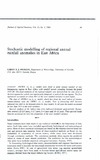| dc.contributor.author | Ogallo, Laban A J | |
| dc.date.accessioned | 2013-06-24T06:29:03Z | |
| dc.date.available | 2013-06-24T06:29:03Z | |
| dc.date.issued | 1986 | |
| dc.identifier.citation | Journal of Applied Statistics, Vol. 13, No. I, 1986 | en |
| dc.identifier.uri | http://www.researchgate.net/publication/233137624_Stochastic_modelling_of_regional_annual_rainfall_anomalies_in_East_Africa | |
| dc.identifier.uri | http://erepository.uonbi.ac.ke:8080/xmlui/handle/123456789/38669 | |
| dc.description | Full Text | en |
| dc.description.abstract | ARIMA (p, d, q) models were fitted to areal annual rainfall of two homogeneous regions in East Africa with rainfall records extending between the period 1922-80. The areal estimates of the regional rainfall were derived from the time series of the first eigenvector, which was significantly dominant at each of the two regions. The first
eigenvector accounted for about 80% of the total rainfall variance in each region.
The class of ARIMA (p, d, q) models which best fitted the areal indices of relative
wetness/dryness were the ARMA (3, 1) models. Tests of forecasting skill however
indicated low skill in the forecasts given by these models. In all cases the models accounted for less than 50% of the total variance.
Spectral analysis of the indices time series indicated dominant quasi-periodic fluctuations around 2.2-2.8 years, 3-3.7 years, 5-6 years and 10-13 years. These spectral bands however accounted for very low proportion of the total rainfall variance. | en |
| dc.language.iso | en | en |
| dc.subject | Stochastic modelling | en |
| dc.subject | Rainfall anomalies | en |
| dc.subject | East Africa | en |
| dc.title | Stochastic modelling of regional annual rainfall anomalies in East Africa | en |
| dc.type | Article | en |
| local.publisher | Department of Meteorology, University of Nairobi | en |

